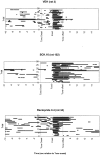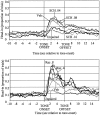Opposing roles of D1 and D2 receptors in appetitive conditioning
- PMID: 12629161
- PMCID: PMC6741989
- DOI: 10.1523/JNEUROSCI.23-05-01584.2003
Opposing roles of D1 and D2 receptors in appetitive conditioning
Abstract
Previous studies have shown that D(1) receptor blockade disrupts and D(2) receptor blockade enhances long-term potentiation. These data lead to the prediction that D(1) antagonists will attenuate and D(2) antagonists will potentiate at least some types of learning. The prediction is difficult to test, however, because disruptions in either D(1) or D(2) transmission lead to reduced locomotion, exploration, and response execution and are therefore likely to impair learning that requires behavioral responding (including exploration of an environment) during the learning episode. Under a paradigm that minimizes motor requirements, rats were trained to enter a food compartment during pellet presentation. Animals then received tone-food pairings under the influence of D(1) antagonist SCH23390 (0, 0.4, 0.8, and 0.16 mg/kg) or D(2) antagonist raclopride (0, 0.2, 0.4, and 0.8 mg/kg). An additional group received unpaired presentations of tone and food. On a drug-free test day 24 hr later, animals that had been under the influence of SCH23390 (like animals that had received unpaired presentations of tone and food) showed reduced head entries in response to the tone, whereas animals that had been under the influence of raclopride showed increased head entries in response to the tone compared with vehicle controls. These data demonstrate that, under a conditioned approach paradigm, D(1) and D(2) family receptor antagonists disrupt and promote learning, respectively, as predicted by the effects of D(1) and D(2) receptor blockade on neuronal plasticity.
Figures




References
-
- Aberman JE, Ward SJ, Salamone JD. Effects of dopamine antagonists and accumbens dopamine depletions on time-constrained progressive-ratio performance. Pharmacol Biochem Behav. 1998;61:341–348. - PubMed
-
- Azzara AV, Bodnar RJ, Delamater AR, Sclafani A. D1 but not D2 dopamine receptor antagonism blocks the acquisition of a flavor preference conditioned by intragastric carbohydrate infusions. Pharmacol Biochem Behav. 2001;68:709–720. - PubMed
-
- Beninger RJ, Miller R. Dopamine D1-like receptors and reward-related incentive learning. Neurosci Biobehav Rev. 1998;22:335–345. - PubMed
Publication types
MeSH terms
Substances
Grants and funding
LinkOut - more resources
Full Text Sources
